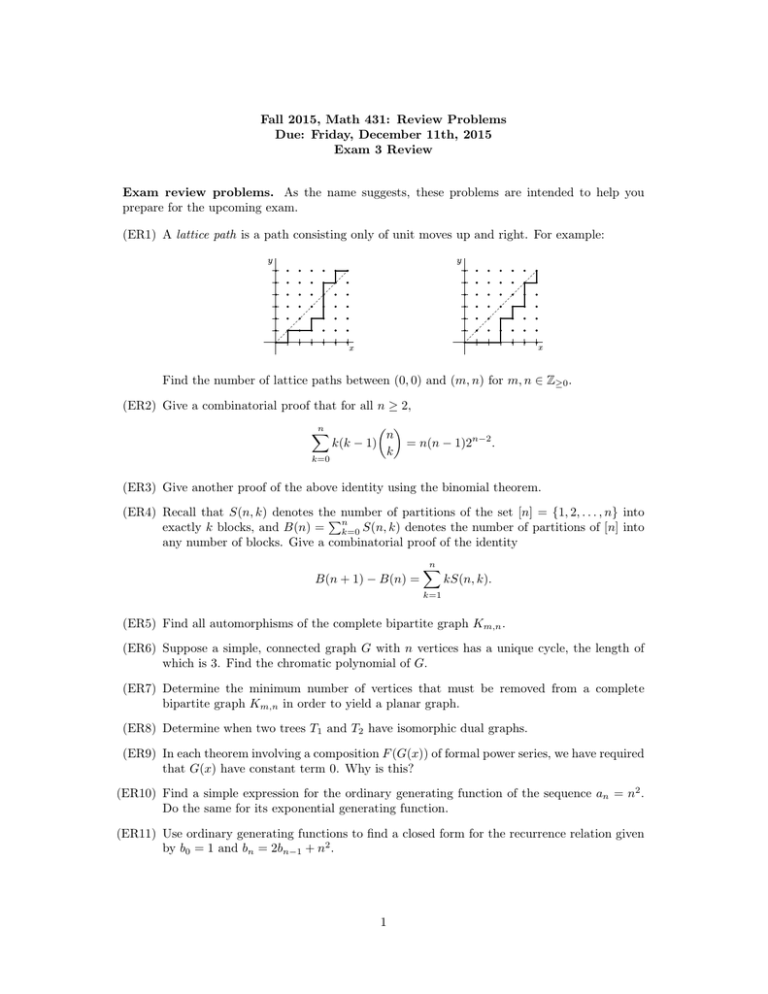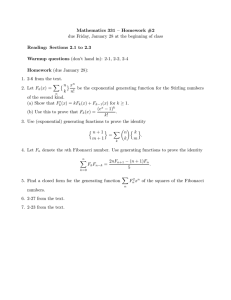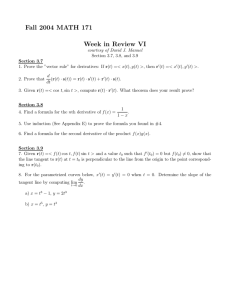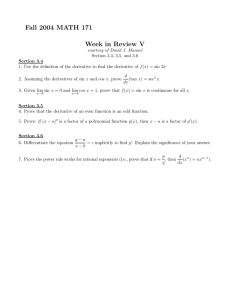Fall 2015, Math 431: Review Problems Due: Friday, December 11th, 2015
advertisement

Fall 2015, Math 431: Review Problems
Due: Friday, December 11th, 2015
Exam 3 Review
Exam review problems. As the name suggests, these problems are intended to help you
prepare for the upcoming exam.
(ER1) A lattice path is a path consisting only of unit moves up and right. For example:
Find the number of lattice paths between (0, 0) and (m, n) for m, n ∈ Z≥0 .
(ER2) Give a combinatorial proof that for all n ≥ 2,
n
X
k=0
n
k(k − 1)
= n(n − 1)2n−2 .
k
(ER3) Give another proof of the above identity using the binomial theorem.
(ER4) Recall that S(n, k) denotes the
of partitions of the set [n] = {1, 2, . . . , n} into
Pnumber
n
exactly k blocks, and B(n) = k=0 S(n, k) denotes the number of partitions of [n] into
any number of blocks. Give a combinatorial proof of the identity
B(n + 1) − B(n) =
n
X
kS(n, k).
k=1
(ER5) Find all automorphisms of the complete bipartite graph Km,n .
(ER6) Suppose a simple, connected graph G with n vertices has a unique cycle, the length of
which is 3. Find the chromatic polynomial of G.
(ER7) Determine the minimum number of vertices that must be removed from a complete
bipartite graph Km,n in order to yield a planar graph.
(ER8) Determine when two trees T1 and T2 have isomorphic dual graphs.
(ER9) In each theorem involving a composition F (G(x)) of formal power series, we have required
that G(x) have constant term 0. Why is this?
(ER10) Find a simple expression for the ordinary generating function of the sequence an = n2 .
Do the same for its exponential generating function.
(ER11) Use ordinary generating functions to find a closed form for the recurrence relation given
by b0 = 1 and bn = 2bn−1 + n2 .
1
P∞
P∞
d
(ER12) Fix power series F (x) = n=0 fn xn and G(x) = n=0 gn xn , and let dx
denote term-byP
P
∞
∞
d
F (x) = n=1 nxn−1 = n=0 (n + 1)xn .
term differentation. For instance, dx
Verify the product rule for formal power series:
d
d
d
(F (x)G(x)) =
F (x) G(x) + F (x)
G(x) .
dx
dx
dx
If you are feeling adventurous, verify the quotient rule for formal power series:
d
d
F (x) G(x) − F (x) dx
G(x)
d F (x)
= dx
dx G(x)
(G(x))2
Where in your proof of the quotient rule did you use that g0 6= 0?
(ER13) Use induction and the product rule for formal power series (given above) to prove
d
d
(F (x))k = k(F (x))k−1
F (x)
dx
dx
for all k ≥ 1. Hint: this can be done without writing any infinite sums.
P∞ 1 n
(ER14) Recall that ex = n=0 n!
x , and consider the formal power series ln(x) defined so that
ln(1 + x) =
∞
X
(−1)n+1 n+1
x
.
n+1
n=0
(a) Justify the above definition by differentiating both sides (using calculus).
(b) Prove that (ex )m = emx for all m ≥ 0. Hint: induct on m.
(c) Prove that ln(ex ) = x.
(d) Pick your favorite algebraic property involving ln(x) and/or ex , and prove that it
holds in formal power series-land. Alternatively, look up the power series expansions
for sin(x) and cos(x) in your favorite Calculus textbook, and prove (using formal
power series) that sin(2x) = 2 sin(x) cos(x), or that (sin(x))2 + (cos(x))2 = 1.
(ER15) For k ≥ 1, find an expression for the exponential generating function
Sk (x) =
∞
X
n=0
S(n, k)
xn
n!
in terms of familiar exponential generating functions (ex , ln(x), etc.). Use this to find
a closed form when k = 1, k = 2 and k = 3. Note: there is no known closed form for
general k, so do not attempt to solve for the coefficients in general!
(ER16) A permutation of [n] = {1, . . . , n} is called indecomposable if it cannot be split into
a permutation on {1, . . . , k} and a permutation on {k + 1, . . . , n} for 1 ≤ k ≤ n − 1.
For example, 54321 is indecomposable, but 23154 = (231)(54) is not.
Let cn denote the number of indecomposable permutations on [n], and let c0 = 0. Find
an equation relating the ordinary generating function C(x) for cn and the
P∞ordinary generating function for the number of permutations of [n], that is, P (x) = n=0 (n!)xn .
2




